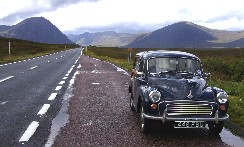It really needs to be a -60 0 +60 Ammeter as well to handle higher ouptut alternators, such as the Sierra flat back that can pump out 47 Amps.
It doesn't make any difference what alternator you have.
What you say is conventional wisdom for cars fitted with alternators, but in reality, whatever maximum rating the alternator has, it will never achieve it if it is connected to a single, starter type battery.
The alternator has a high rating because it has to power everything on the car, as well as charging the battery. It "sees" the battery as just another load to provide power to, along with the lights, heater etc.
The ammeter is measuring what is going into or out of the battery, not what's coming out of the alternator. That is a different thing.
On the charge side, maximum charge current for a standard battery will be limited by the battery chemistry and constuction to about 20% of the battery rated capacity. If you have a big battery, say 60 Ah (standard would be 35 Ah), you'd never see it charge at more than 12-15 A, even when flat. i.e. whatever the alternator's maximum output, you won't be able to "pump" it through a single battery. The battery "takes" what it can, no more.
On the discharge side of the battery, side lights, main beams, a couple of front and rear fog lights, rear screen heater, a radio, the heater motor and wipers would take about 500 Watts.
That's about 40 A with 12.5v, i.e. everything on with the engine not running and a nicely charged battery. but heavy loads like the heated rear screen should be wired so they can only be run with the engine running, and not many people turn everything on before they start the engine anyway.
The ammeter is measuring what's going into, or out of the battery, so as long as the engine is running and the alternator charging, you have to offset what it is producing to charge the battery against the load coming out to get the reading that would be displayed on the ammeter.
In practice, I have a 30 - 30 ammeter fitted on my Minor, and I can't get more than about - 15 A with everything on and the engine stopped. (The horn would take more, but that isn't wired through it).
Similarly, maximum charge rate is about 8 A with a flat battery.
The reason I fitted a 30 - 30 meter is that it has a bigger needle deflection for a given current, so it easier to see what is going on in a normal set up.
I used to have a 60 - 60 meter, and the needle barely moved.
Maybe that's why people don't think ammeters are particularly useful.
Oh, and for trivia fans, an ammeter is, in fact, just a voltmeter with a big shunt ( a very low resistance circuit) to take the actual current. It measures the voltage drop (or rise) across the known resistance of the shunt.



